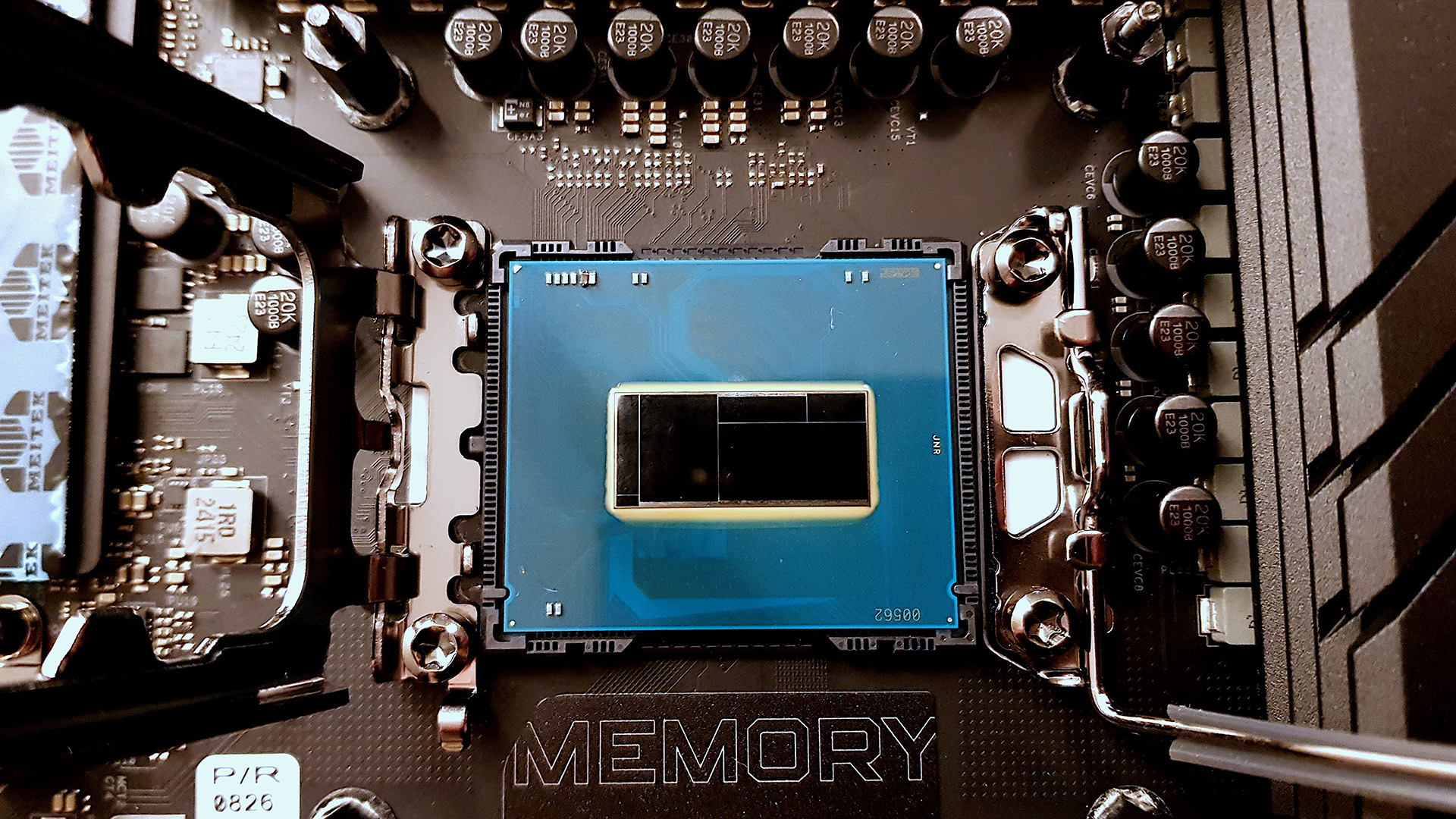Intel prepping Arrow Lake Refresh with minor clock speed bump and new Copilot+ AI-compliant NPU lifted from Core Ultra 200V — reportedly launches in the second half of 2025
A nominal upgrade for most.

Intel isn’t done with Arrow Lake yet. After having launched a total of 22 locked and unlocked SKUs since last year's not-so-incredible launch, the company is now looking forward to the next wave. According to ZDNet Korea, a refresh of the Arrow Lake-S desktop lineup is reportedly set for release in the second half of 2025, and while it won’t introduce new core architectures, it will bring minor upgrades to (try to) stay competitive, including a bulked-up NPU that supports CoPilot+. Expect slightly higher clock speeds thanks to better silicon binning and refinements on the Intel 20A process, which introduced RibbonFET and PowerVia in Arrow Lake’s initial release.
This new report comes after a previous leak from @momomo_us, who shared motherboard reference documents revealing the existence of Arrow Lake 2.0, if you will. As such, the refresh will remain on the LGA 1851 socket and continue to use 800-series chipsets, ensuring that current motherboards remain fully compatible and extend their life for one final generation before Nova Lake replaces them next year.
Core configurations reportedly won’t change—Lion Cove P-cores and Skymont E-cores are staying the same—but firmware and tuning optimizations will likely lead to a boost in efficiency. Intel has been trying its best to gain whatever ground possible when it comes to squeezing more juice out of Arrow Lake with updates like Core Boost 200S at Computex earlier this year, and "IPO" optimized memory profiles that are currently live in China with various system integrators.
Moreover, one notable upgrade is the rumored new NPU4, which would make its debut on Arrow Lake-S refresh after its introduction in last year's Lunar Lake mobile chips. The original Arrow Lake desktop CPUs shipped with NPU3 (from Meteor Lake) which only had 13 TOPS of AI power, short of Microsoft’s Copilot+ AI PC requirements of at least 40 TOPS. The refresh is expected to surpass that with 48 TOPS, which will be able to handle the increasing demands of local AI workloads. With AI features becoming more central to consumer usage, this NPU upgrade is likely Intel’s main play. It should allow the company to brand these chips as AI-ready.
There’s no indication yet of how Intel will brand the refresh—whether it’ll fall under the same Core Ultra 200 series umbrella or branch off as a new tier—but this is more of an iterative performance uplift than a fully-blown new generation. It’s likely a strategic move to extend Arrow Lake’s shelf life while the company gears up for Nova Lake, which is still expected in 2026 on the Intel 18A node.
ZDNet Korea also reported that Intel's actual next-gen architecture is still more than a year away since the launch is currently scheduled for H2 2026. Till then, Intel's declining market share will have to cling on for dear life as the market continues to see red.
Get Tom's Hardware's best news and in-depth reviews, straight to your inbox.

Hassam Nasir is a die-hard hardware enthusiast with years of experience as a tech editor and writer, focusing on detailed CPU comparisons and general hardware news. When he’s not working, you’ll find him bending tubes for his ever-evolving custom water-loop gaming rig or benchmarking the latest CPUs and GPUs just for fun.
-
usertests It's still a boring refresh on the CPU side, but the interesting thing is that they are actually swapping a chiplet out for a new chiplet to get that 3x larger NPU. There is nothing stopping them from swapping in a newer iGPU or video block at the same time.Reply -
DS426 Reply
Yep -- starting to see how Intel's tiles allow them to swap around bits and bobs, allowing refreshes to actually be a little more interesting, even if not really in this case with most not caring about more AI performance. Not so much on desktop but on mobile, an iGPU upgrade like you mentioned could spice things up.usertests said:It's still a boring refresh on the CPU side, but the interesting thing is that they are actually swapping a chiplet out for a new chiplet to get that 3x larger NPU. There is nothing stopping them from swapping in a newer iGPU or video block at the same time. -
bit_user This is potentially good news, as the NPU resides in the same tile as the memory controller. If this change can do anything to improve memory latency, that should help with some of Arrow Lake's deficits.Reply
Source: https://www.techpowerup.com/336412/inside-arrow-lake-intels-die-exposed-and-annotated
I wonder if they'll be making room for the larger NPU by shifting some more PCIe lanes into the I/O tile, which could then use up some of the empty space in the lower-left corner. Otherwise, not only would the entire silicon area get larger, but the CPU cores would probably be pushed even further off-center. -
bit_user Reply
I highly doubt it. MS probably faced enough backlash from obsoleting CPUs for Win 11. The last thing they need is to obsolete even new CPUs that someone could go out and buy today. That basically guarantees people will leave Windows in droves.baboma said:Safe bet that MS' 40 TOPS NPU will be a Win12 requirement.
For Windows 13... maybe.
Or, maybe that Nvidia is still trying to sell some RTX 4000 inventory + RTX 5000 models, while AMD didn't have much to brag about until RX 9000.baboma said:Edit 2: Perplexity is partially wrong (hah again!). Spot checks show that 4000 series do have TOPS specs listing, but not 2000 or 3000. So maybe 4000 GPUs will pass muster.
Edit 3: Radeon RX 9000 series likewise have TOPS listed, but not 7000 or 6000 series.
The whole world doesn't revolve around Windows AI, you know? There can be things that have either nothing or very little to do with it. -
TerryLaze Reply
Yeah no, all or at least most CPUs that will be made by that time will have enough TOPS but windows 12 will not require it.baboma said:>...and an entirely new NPU focused on delivering Copilot+ AI prowess.
Just one more piece of the "Windows AI" puzzle falling into place. All new PCs by default will be AI PCs when new Windows rev launch next year (call it Win12). Safe bet that MS' 40 TOPS NPU will be a Win12 requirement.
The whole point of copilot and other marketing words is to make it clear that if you buy a PC without the buzzwords on it then it won't have it. -
thestryker Reply
My bet is node shrink since they're still using N6 for the SOC Tile. The LNL NPU (which seems to be the most likely candidate) is somewhere around double the size of the ARL one.bit_user said:I wonder if they'll be making room for the larger NPU by shifting some more PCIe lanes into the I/O tile, which could then use up some of the empty space in the lower-left corner. Otherwise, not only would the entire silicon area get larger, but the CPU cores would probably be pushed even further off-center.
A new Graphics Tile seems very unlikely, but since there is a new SOC Tile then a new media engine isn't impossible.usertests said:There is nothing stopping them from swapping in a newer iGPU or video block at the same time. -
SomeoneElse23 Reply
I don't know why anyone would want "AI" in their PC.bit_user said:The whole world doesn't revolve around Windows AI, you know? There can be things that have either nothing or very little to do with it.
In today's internet connected world, *if* AI goes anywhere, and it's a big IF, online will be far better than anything you can get from a PC. -
TerryLaze Reply
I bet you anything that more people want A.I. on their PCs than there were people that wanted 20+ cores in their CPUs ,but here we are.SomeoneElse23 said:I don't know why anyone would want "AI" in their PC.
In today's internet connected world, *if* AI goes anywhere, and it's a big IF, online will be far better than anything you can get from a PC. -
TerryLaze Reply
The last time before TPM that windows required new hardware was for 64bit ,baboma said:>Yeah no, all or at least most CPUs that will be made by that time will have enough TOPS but windows 12 will not require it.
Exactly. All new PCs will have CPUs that qualify, and they will all come with Win 12. No requirement is needed.
The question is whether existing PCs will get a Windows upgrade to 12. MS made some HW requirement for 10->11 upgrade, and with Win12's crux being on AI, it's logical to carry the Copilot+ HW req over to Win12 req.
Put differently, if you have a Win11 box and you don't want AI, there's little point in upgrading to Win12. If you do want AI in Win, 40 TOPS is already a req now.
As said, it'll be interesting to see how MS handles the transition. For new non-AI Win12 features--are there any worth speaking of?--MS can do as it did for Win10, which is to backport certain features. Win11 25H2 has a 2-year update window, so it's good until '27. Depending on userbase uptake, MS can well extend the window for Win11 support.
>The whole point of copilot and other marketing words is to make it clear that if you buy a PC without the buzzwords on it then it won't have it.
Per above, this is superfluous for new PCs (in '26).
They are not doing it with every version just to annoy people.
MS is constantly adding hardware specific things without making it a requirement for the new version.
For example they added thread director for intel CPUs without forcing everybody to have a CPU that supports it.